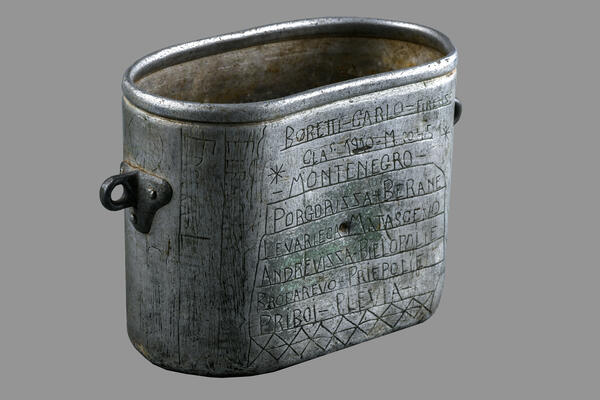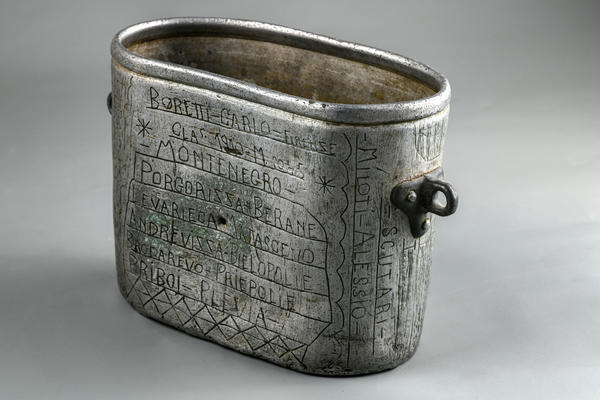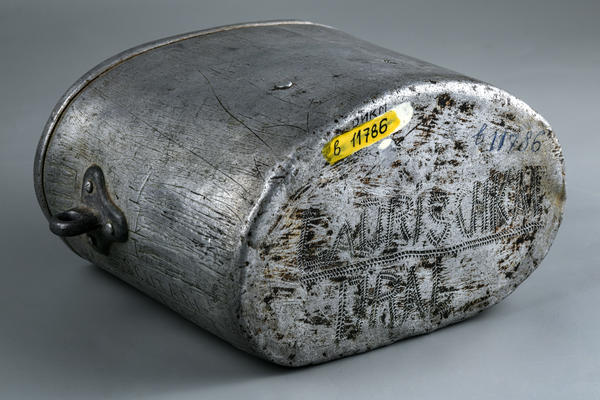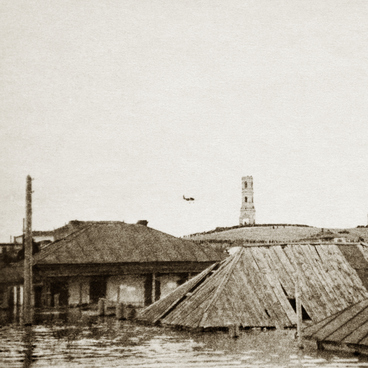The standard aluminum mess tin of an Italian soldier is noteworthy for the text written on it. It translates to: ‘Carlo Boretti - Florence - Born - 1910 - Died - 1945.’ The geographical names of the following oblasts and cities in the Balkan peninsula are listed below: Montenegro and its towns: Podgorica, Berane, Andrijevica, Bijelo Polje and others. The Serbian town of Priboj. Albanian towns including Scutari and Lezhë (known as Alessio in Italy). These are the places where the 19th Italian infantry division were active between 1939 and 1943, taking part in the Albanian occupation and the Greco-Italian war. By July 1941, the ‘Venice’ division went to Montenegro, occupied Podgorica, Berane and Kolashin, engaging in active anti-partisan conflict.
Mess Tin belonging to Carlo Boretti
Размер
20х20х40 cm
Техника
factory made
Коллекция
3
Открыть в приложении#1
Unknown author
Mess Tin belonging to Carlo Boretti
#2
#3
1 / 2
Inscriptions on Carlo Boretti’s Mess Tin
#8
On 8 September 1943, in the middle of the Second World War, Italy declared an armistice between itself and the anti-Hitler coalition. On 13 October 1943, Italy declared war on Nazi Germany. On the day of the armistice, the 19th ‘Venice’ infantry division was billeted in Podgorica. The 118th Wehrmacht infantry division planned to disarm the soldiers, however the Italians refused to drop arms. Many of the troops moved across to the side of the Yugoslav partisans at the beginning of October: on 10 October 1943, the Italian soldiers’ support for the partisans was declared. The Italians fought hard for thirteen months against the Wehrmacht forces, in the towns of Brodarevo, Murina, Berane and Kolashin. On 1 December 1943, the remaining troops of the 19th infantry division and the 1st Albanian division merged into a single Italian partisan division, called ‘Garibaldi’.
The mess tin came to the museum quite by chance. The person who had discovered it was not aware of its story. For a while, museum staff believed that the mess tin belonged to an Italian prisoner of war in the POW camp № 260, in Orsk.
The mess tin came to the museum quite by chance. The person who had discovered it was not aware of its story. For a while, museum staff believed that the mess tin belonged to an Italian prisoner of war in the POW camp № 260, in Orsk.
The Russian State War Archive then provided the museum with a copy of Carlo Boretti’s POW registration card, so we now know that he was from Campi Bisenzio, near Florence, and was a worker. In 1930 he was conscripted. He served as a rifleman in the ‘Venice’ infantry division. He was captured on 7 July 1944 near Vilnius. On 31 May 1945, he entered clearing hospital № 5951 in Kirsanov, Tambov Oblast. He died from pulmonary tuberculosis on 3 October 1945.
This shows that Carlo Boretti was never in Orsk. And yet, somehow his mess tin ended up in our city. The registration card does not answer the question how Carlo Boretti ended up near Vilnius, and whether his division fought in the Balkan peninsula. Therefore, the study of this mess tin’s history is far from over.
This shows that Carlo Boretti was never in Orsk. And yet, somehow his mess tin ended up in our city. The registration card does not answer the question how Carlo Boretti ended up near Vilnius, and whether his division fought in the Balkan peninsula. Therefore, the study of this mess tin’s history is far from over.
#9
Orsk Museum of Local Lore
читать дальшескрыть
00:00
00:00
1x
Mess Tin belonging to Carlo Boretti
Размер
20х20х40 cm
Техника
factory made
Коллекция
3
Открыть в приложении
Поделиться





